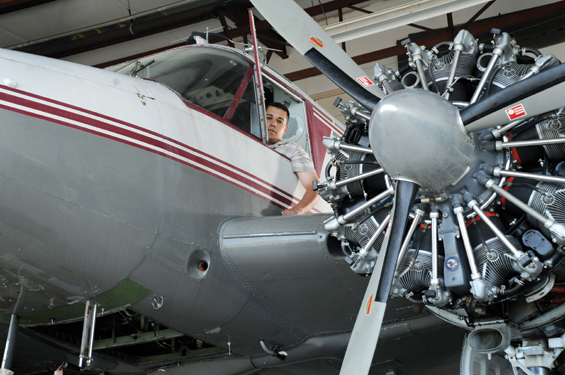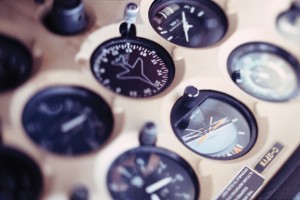Audio Panels

In today’s General Aviation (GA) cockpit communications has evolved from the hand signals that pilots and crew used to use in the old tandem seat, open cockpit aircraft. Today we use amplified microphones and active noise cancelling headphones to get our points across. These improvements have allowed us to transverse congested airspace and multitask in an environment overloaded with information. A major connection point for all these fancy avionics and you is usually the smallest piece of equipment in your radio stack – the audio panel. In the old days, it used to be known as the audio selector because it did just that: select which radio you were using by means of physical switches. Today, these audio panels no longer use as many knobs or buttons, as electronics can do so much more. Here are just a few examples of the features of the common audio panels on the market.
FAIL SAFE OPERATION
Modern audio panels are electronically switched. This means no more mechanical parts that can jam or break. That, however, does not mean that the new ones are impervious to breakage. Instead, most audio panels today come with a fail safe feature. When in this mode, the pilot is connected to his or her number one radio. All the other crew/passenger positions will not operate. To activate this operation, generally you use the knob on the left of the unit either by turning it fully counterclockwise or by depressing it. This is an easy feature to test and should be done periodically. For those of you flying Garmin G1000-equipped aircraft, the audio panel can also switch the Primary flight display indications on the pilot side to the multi-function display on the co-pilot side by means of the Big Red Button. Yup. It’s red and it’s big.
ICS(PILOT)/CREW/ALL modes
The ICS or InterCom System on today’s audio panels has eliminated the need for hand signals, though some flight instructors have been to known to use the ones that involve their hand and the back of your head. The ISO (or Pilot) mode, for instance, allows the pilot to isolate him/herself from the rest of the yapping masses aboard the aircraft in order to concentrate on communicating with ATC or to focus on a challenging phase of the flight. Of course, such a feature can also be used to isolate oneself from the cabin conversation in general, without having to give any reason (too bad an ISO hasn’t been developed for outside the cockpit. Just imagine the possibilities!). In this mode the pilot only hears the selected radios and audio alerts, no entertainment audio and no side-tone unless transmitting. The co-pilot and passengers will be able to use the intercom and hear their respective entertainment audio.
In CREW mode the pilot and co-pilot can hear the radios, main entertainment input and each other, while passengers only hear the entertainment.
In ALL mode everyone on board can hear the selected radios, each other and the entertainment.
THE SPLIT MODE
This mode allows the pilot and co-pilot to transmit using comm 1 and comm 2 radios, respectively. In some models, especially older ones, the pilot’s audio is passed to the speaker regardless of the position of the speaker select switch. Although this feature is easy to activate in some models, others require you to push comm1/select and then depress comm2 while still holding comm1. Cancellation of this mode is usually the reversal of activation. The ICS feature between the crew however, will not work while the panel is in split comm.
 THE ALL-IMPORTANT ENTERTAINMET INPUTS (a.k.a. MUSIC)
THE ALL-IMPORTANT ENTERTAINMET INPUTS (a.k.a. MUSIC)
The arrival of music onboard aircraft came with a carry-on of blessings and headaches. While it provides our sometimes less-than-thrilled passengers with a little distraction during long flights, this is one of those utilities that can cause grief when trying to figure out just how to make the darn thing work right. The functions definitely vary greatly between models. Some models have one input while others have dual inputs. The number one input is usually for the crew and the second is usually for the passengers.
Panels come with a number of ways to mute the music playback when necessary, with the default option often being an automatic drop in volume when any transmission is received or the ICS squelch is broken (this is called ‘Ducking’). The other is the “always on” or “Karaoke” mode, in which the music is always present in the headphones, regardless of radio or intercom audio. This mode is activated in some models by either depressing the ICS key, simultaneously depressing for 5 seconds the NAV1 and NAV2 buttons, or a remote switch. For passengers, the only option for selecting the karaoke mode is via a remote switch.
The arrival of XM weather and audio channels through handheld devices has brought with it a host of annoying problems, not the least of which is NOISE! Thanks to the audio panel and modern headsets, the cockpits of most GA aircraft are quieter than ever – which means that even small amounts of noise can be heard. Electrical alternator noise is a major culprit of headaches, as it is often picked up and amplified in the handheld unit’s amplifier. Determining the cause of the whine on music playback is easy, simply power down the unit – chances are the noise will be gone.
INOP (InOperative Panel)
So now what? What happens when the panel doesn’t work? First try the failsafe function. Granted, these units are so reliable that it is unlikely that you will ever need it, but be very glad it’s there just in case.
Honestly, you are more likely to experience noise and intermittent operations that will require troubleshooting than you will come across a panel that stops working competely. Here are a few things that you can try on your own before leaving that all-important note for your tech – the one that explains what you tried to do to resolve the problem before abandoning the gear for him/her to fix. Who knows? It may even save you a trip to the avionics shop (fingers crossed).
If noise is the issue:
- Systematically start powering down systems and units one at a time to find the offender. (e.g. radios, transponders, turn cord, beacons, etc)
- If the whining noise follows the throttle, try shutting down the alternator.
- If it is a popping sound, run on one mag at a time (on the ground, please).
- If you have music, see if it goes away when you turn the unit completely off.
If the issue is broken receive or transmit, low volume, squeals or just distorted audio:
- Make sure that your microphone and phone jacks are tight when inserting the headsets plugs, and that the nuts don’t turn.
- If you are experiencing transmit cutoffs, look at the transmit indication on the radio and/or audio panels when depressing the transmit switch. Make sure it stays lit. If not, try to see if the other position does the same. If not, you may need a new switch (preferably one with less finger grime).
- Keep the plugs of your headset clean.
- Just simply push on the radios. Place your thumbs on both sides of the radios and give it a good push, inwards toward the firewall. Just make sure that you do it on the edges and away from the screen and knobs. This may reseat any behind-the-scenes connections that might have loosened.
Again, be sure to – correspond/communicate as much as you can with your avionics tech about your problems before your visit. It will help you avoid any unnecessary headaches down the road.
Thank goodness the advances in aviation audio technology have brought flying in general aviation aircraft a long way from the noisy, headache-inducing experience it was even a few decades ago.





